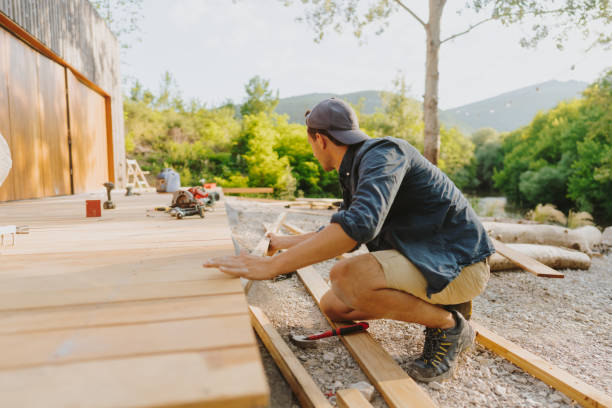How Patio Construction Services Handle Drainage Issues Before Building?

Before building a patio, it is essential to check the ground. The ground is like the patio’s bed—it has to be strong and dry. The team offering Mountlake Terrace patio construction services always studies the soil before starting work. This step helps ensure the patio will remain stable for a long time. If the ground is too soft or too wet, the patio can crack, sink, or tilt. That’s why they fix these problems before building. Preparing early keeps the patio safe and saves a lot of money later.
Why Soil Type Matters More Than You Think: Get Mountlake Terrace Patio Construction Services
Soil can behave very differently depending on its composition. Clay soil holds too much water and becomes sticky. Sandy soil allows water to pass through quickly but doesn’t retain its structure. The best kind is loamy soil—it’s a mix of clay, sand, and silt, which keeps it balanced. Builders check the type of soil under the patio area. If it’s too weak or loose, they add gravel or a stronger mix to strengthen it. This makes the base solid and keeps the patio in place even after heavy rain.
Digging Deeper with Soil Testing
Soil testing is like checking the health of the ground. Builders dig small holes around the area to see how deep the topsoil is and how strong it feels. They test how much water it holds and how tightly it’s packed. If it’s too soft or too wet, they mix in crushed stone to make it firm. This makes sure the patio won’t sink later. Soil testing helps builders plan everything correctly from the start.
Tip: Testing the soil early helps avoid cracks and costly repairs later.
The Hidden Role of Drainage in Patio Building
Water might seem harmless, but it can cause big problems. If rainwater accumulates under a patio, it can weaken the soil beneath it. That’s when cracks or holes begin to appear. That’s why experts offering general contracting services in Mountlake Terrace WA, always check drainage before building. They study where the water flows and make sure it moves away from the patio. Sometimes, they create gentle slopes or add special drains. This helps keep the patio dry, safe, and sturdy, regardless of the amount of rain.
Using the Right Tools for the Job
After checking the soil and water flow, the builders use special tools to prepare the ground. Laser levels help them set perfect slopes. Compactors press the soil down, compacting it into a solid mass. Trenchers dig small channels for drains. These tools help builders do the job carefully and correctly. When the soil is smooth and firm, water naturally moves away from the patio. This keeps the surface dry and stops future damage.
How Professionals Deal with Uneven Terrain
Some yards are not flat—they have bumps or slopes. Professionals offering Mountlake Terrace patio construction services address this issue by grading the land to ensure a stable foundation. Grading means leveling the ground by moving soil around until it’s even.
If the slope is too steep, they add small walls called retaining walls. These walls hold the soil in place and stop it from sliding. Sometimes, they build steps to make the patio blend better with the land. This makes the space both safe and visually appealing.
Moisture Barriers: A Small Detail That Makes a Big Difference
Before laying stones or pavers, builders often add a moisture barrier. This is a thin layer that keeps water from coming up through the soil. It can also be plastic, fabric, or a special waterproof sheet. This layer keeps the sand or gravel under the patio dry. Even when it rains heavily, the patio remains sturdy. A moisture barrier might seem small, but it protects the patio from damage caused by water.
Planning for Long-Term Water Control
Good patios are built to last for many years, not just one season. That’s why experts offering Mountlake Terrace patio construction services also plan for future rain. They often incorporate hidden tools, such as French drains or catch basins, to enhance the drainage system. These collect extra water and send it away from the patio.
Sometimes, they plant bushes or flowers that naturally absorb rain. These plants make the area pretty while also keeping the soil from getting too wet. Moreover, with these smart ideas, the patio stays strong through every season.
Expert Insight: “You can’t stop the rain, but you can guide where it goes.”
Quick Look at Soil & Drainage Fixes
| Problem Found | Simple Fix |
|---|---|
| Clay soil holds water. | Mix in gravel or sand for better drainage. |
| Water pools in one spot | Add a drain or make the ground slope slightly. |
| Loose sandy soil | Press it down and mix with stronger materials. |
| Sloped yard | Build retaining walls or add small steps. |
| Too much moisture below | Use a moisture barrier and a thicker base layer. |
This table illustrates how builders address various soil and drainage issues. Each fix helps make a patio strong and safe.
Real Talk: What Happens If Soil and Drainage Are Ignored?
If builders skip soil and drainage work, patios can fail quickly. Cracks start to show, or the surface becomes uneven. Rainwater might collect on top or under the patio, making it unsafe. As one expert said, “You build a patio on the ground, not just on stones.” Without solid soil and good drainage, even the best patio designs won’t last. Fixing such problems later costs much more than doing it right from the beginning.
Creating Outdoor Spaces That Last and Impress
When patios are built on firm soil with effective drainage, they remain beautiful and sturdy for an extended period. People can sit, play, or relax on them without worry. The key is good planning—ensuring that every layer, from the soil to the top, is prepared for all kinds of weather. A well-prepared patio not only looks aesthetically pleasing but also enhances the home’s value. It also becomes a safe and happy space for families to enjoy every day.
Bergquist Designers & Builders LLC provides patio construction services and general contracting services that create patios built to last. The company focuses on strong foundations, smart water control, and designs that keep homes both safe and beautiful for years to come.


